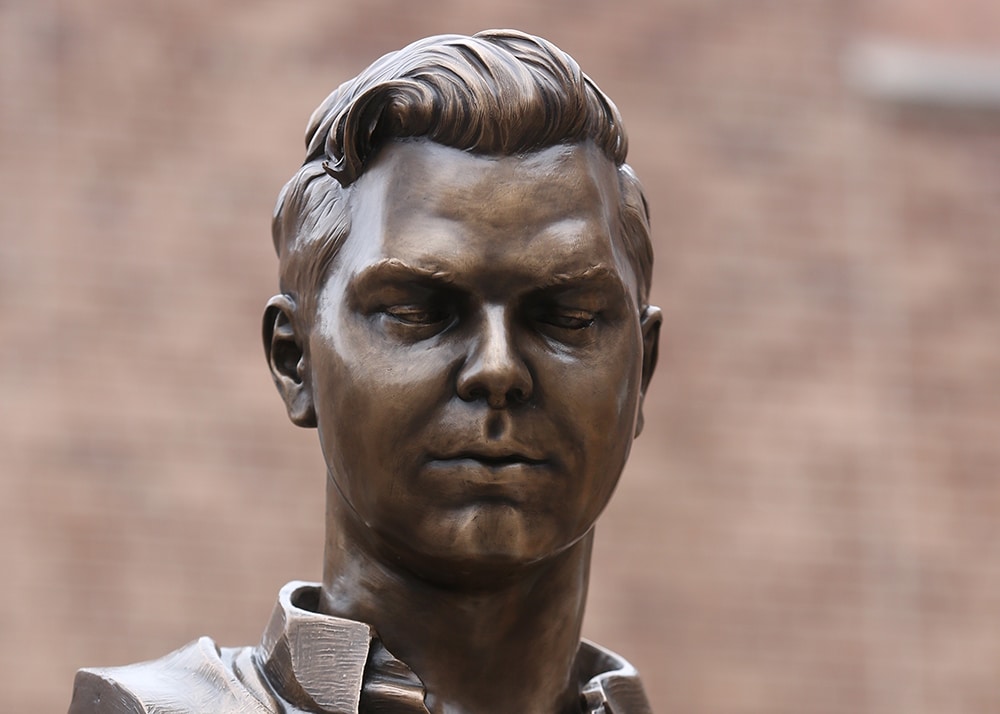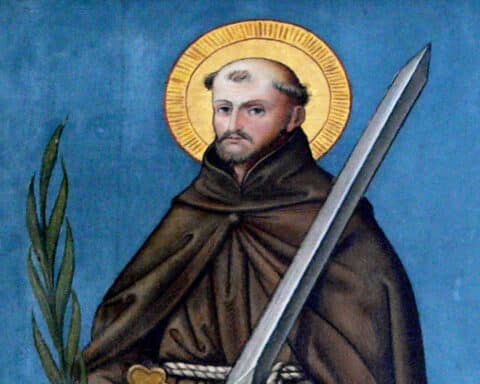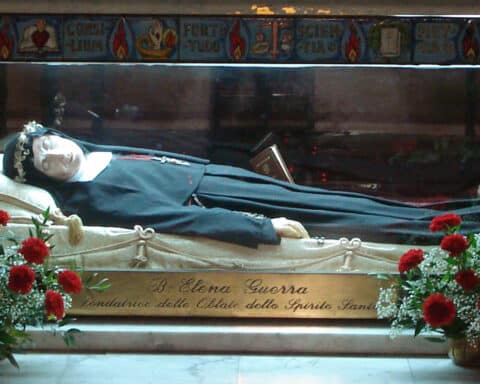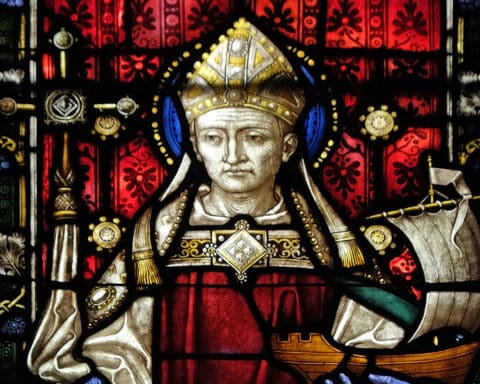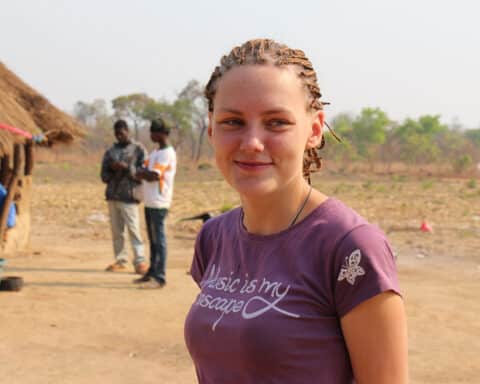The legacy of Blessed James Miller — or better known among the Guatemalans he served as “Hermano Santiago,” the Spanish version of “Brother James” — was recalled at his Dec. 7 beatification in Huehuetenango, Guatemala. The De La Salle Christian Brother was killed in 1982 at a school where he ministered. Declared a martyr last November, Blessed James is the first religious brother from America to be beatified.
With a simple life and heroic faith, Blessed James offered his life for the success of Catholic education among the rural Guatemalan communities he served. At the beatification Mass, celebrated on soccer fields at the Guatemalan school where the newly beatified once served, papal delegate Panamanian Cardinal José Luis Lacunza Maestrojuán said in his homily that “Catholic education belongs to the evangelizing mission of the Church.”
“The pastoral work of Hermano Santiago so consumed him to the point of him being murdered. There is nothing that makes authoritarians uncomfortable — be it on the left or the right, be it from yesterday or today — than education. That is why they were so adamant to suppress the freedom to teach, and to suppress education itself, even if they had to deny a basic human right like a parent’s right to choose the education they want for their children,” said Cardinal Lacunza.
The Wisconsin native became just the second native-born American designated as a martyr, after Blessed Stanley Rother of Oklahoma, who was beatified in 2017. Blessed James’ death came almost seven months after Father Rother was also killed in Guatemala.
Wisconsin farm roots
Born prematurely in Stevens Point, Wisconsin, on Sept. 21, 1944, Blessed James was a farm boy through and through. Brawny in stature and kindhearted by nature, he had a jovial personality and animated laugh. He entered the Institute of the Brothers of Christian Schools, or more simply known as the Christian Brothers, after high school. After professing first vows in 1962, Blessed James took the religious name Brother Leo William, although he later reverted to using his baptismal name.
First assigned to high school ministry in Minnesota, Blessed James taught Spanish, English and religion and coached football. He also was in charge of maintenance for the facility, earning him the nickname “Brother Fix-It.”
Blessed James professed perpetual vows in 1969. Not long after, he ministered in Nicaragua where he taught and directed a vocational school, which doubled in size under his leadership. Under his watch, there was the construction of nearly a dozen schools on the outskirts. The Sandinista revolution brought hardship and suffering to the Nicaraguans. Blessed James’ life was endangered during this period. Later reassigned to Minnesota again, he longed to return to Central America.
Guatemala
In early 1981, Blessed James was assigned to Guatemala. There he taught in Huehuetenango, located in a mountainous western area of the country. His compassionate heart opened him to the suffering and oppression of the local community. He set out to help them overcome poverty by providing job skills training among their youths. There was only one teacher for every 400 children in the country. He did all he could to help the mission succeed, willingly taking on the most ordinary of tasks, from sweeping floors to doing dishes. Blessed James also utilized his conversation skills to attempt negotiations with politicians and he exhibited community leadership in organizing a fire department.
Blessed James was keenly aware of poverty and oppression among the Guatemalan natives he served. “Many selfish, blind and hardened hearts must be converted to the love of Christ before a lasting solution can be found. Armed force will not solve the problems; only dialogue and mutual understanding can be viable solutions,” he wrote.
It is clear Blessed James’ love for the poor and his desire to serve them in the name of Christ ultimately brought about his death — a risk of which he was fully aware. “I am personally weary of violence, but I continue to feel a strong commitment to the suffering poor of Central America. ‘God’s ways are not man’s ways,’ says the Bible. God knows why he continued to call me to Guatemala, when some friends and relatives encouraged me to pull out for my own comfort and safety,” Blessed James wrote.
Similar to his time in Nicaragua, the political situation in Guatemala was alarming. The Church was hated for its vocal opposition to the oppression of the poor and vulnerable. As a result, missionaries and other clergy and religious were endangered by threats, torture and kidnap, or even murder.
Assassination
Blessed James was shot and killed on Feb. 13, 1982, by three hooded men as he was atop a ladder in midday while repairing a wall at his school. Students of De La Salle Indian School in Huehuetenango were looking on. Blessed James was 37 years old at the time of his death. His assassins were never identified, and the investigation was closed after the government concluded “subversive criminal elements” were to blame.
After Brother James’ murder, the Christian Brothers deliberated leaving Guatemala. But they decided “the greatest legacy to our Brother James Miller would be for the work of the De La Salle Brothers to continue.”
Cardinal Lacunza summed up Blessed James’ legacy at the Dec. 7 beatification Mass: “Brother Santiago, through his pastoral work to indigenous peoples and the poorest of the poor, was aware of their dignity and their rights and of responsibilities, because he challenged the authoritarian and abusive system of those who thought only of themselves.”
And after funeral ceremonies in Guatemala and Minnesota, Blessed James was buried in his native Wisconsin at his family’s parish cemetery in Polonia. His cause of canonization was opened in 2009. An authenticated miracle will be necessary for his canonization.
Michael R. Heinlein is editor of OSV’s Simply Catholic. He writes from Indiana.
| Holiness in Wisconsin |
|---|
|
The beatification of Blessed James Miller is a time for celebration not only in Guatemala but also in the United States, particularly in his native Wisconsin. Here’s a look at several other individuals who have called Wisconsin home and have causes of canonization that have been introduced.
Blessed Solanus Casey
Beatified in 2017, Capuchin friar Blessed Solanus Casey was the first American-born religious priest so designated by the Church. He was was born to Irish immigrants in Wisconsin in 1870. Not considered to have enough intelligence to preach and hear confessions, Blessed Solanus was ordained a “simplex priest” and was often given menial tasks around the friary. As the doorkeeper, the number of visitors grew steadily through the years because so many sought his counsel or asked for his prayers. He was also known to have performed miracles and possessed many supernatural gifts. In 1957, he died in Detroit, where a shrine is now dedicated in his honor. Venerable Father Samuel Mazzuchelli
A cause of canonization was opened for Father Mazzuchelli in 1964, and he was declared “venerable” in 1993. The Italian Dominican friar was a pioneer missionary throughout a sizable portion of the upper Midwest, establishing parishes — even often serving as architect for the churches — throughout the area where Illinois, Iowa and Wisconsin intersect. Many schools and colleges trace their origin to his ingenuity, as well as the Sinsinawa Dominican Sisters. Unable to pronounce his surname, the Irish to whom he ministered called him “Father Matthew Kelly.” He died at 57 in 1864 and is buried in the parish cemetery in Benton, Wisconsin. Servant of God Father Joseph Walijewski
Born in Michigan in 1924, the son of Polish immigrants, Father Joseph Walijewski was ordained a priest for the Diocese of La Crosse, Wisconsin, in 1950. He served first in diocesan parishes — including a parish in Stevens Point, Wisconsin, the hometown of Blessed James Miller. As a South American missionary, Father Walijewski first served a decade in Bolivia. After a stint back in Wisconsin, he went to Peru. There he served for decades as pastor on the edge of Lima, established an orphanage and helped build other necessary social services. He died in Lima in 2006 and a cause of canonization was introduced in the Diocese of La Crosse in 2013. Servant of God Sister Thea Bowman
Born in Mississippi in 1937, Sister Thea Bowman spent several years in formation or service in the Diocese of La Crosse, Wisconsin. Years after her conversion to Catholicism at age 9, Sister Bowman entered the Franciscan Sisters of Perpetual Adoration in La Crosse. She taught at various apostolates her community operated in La Crosse. Sister Bowman is also remembered for her work of evangelization, dedication to racial harmony and contributions to ministry among African-American communities. She died in her native Mississippi in 1990 and is buried next to her parents in Memphis, Tennessee. Her cause of canonization was opened in the Diocese of Jackson, Mississippi, in 2018. |

